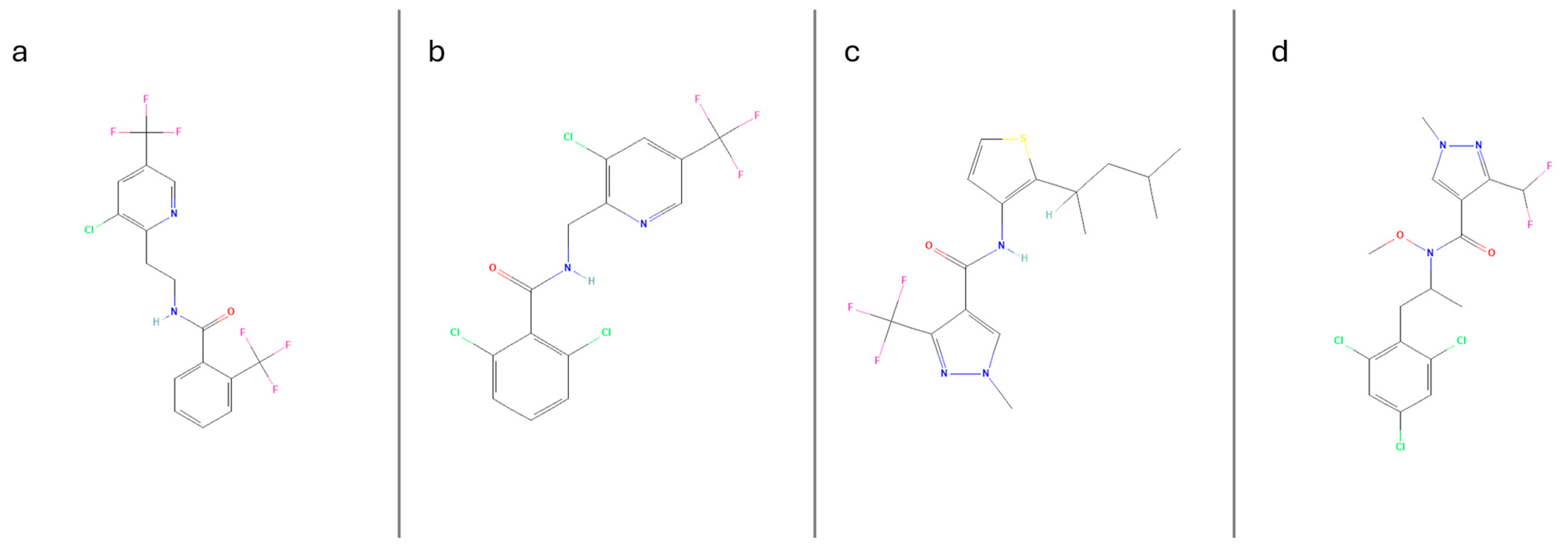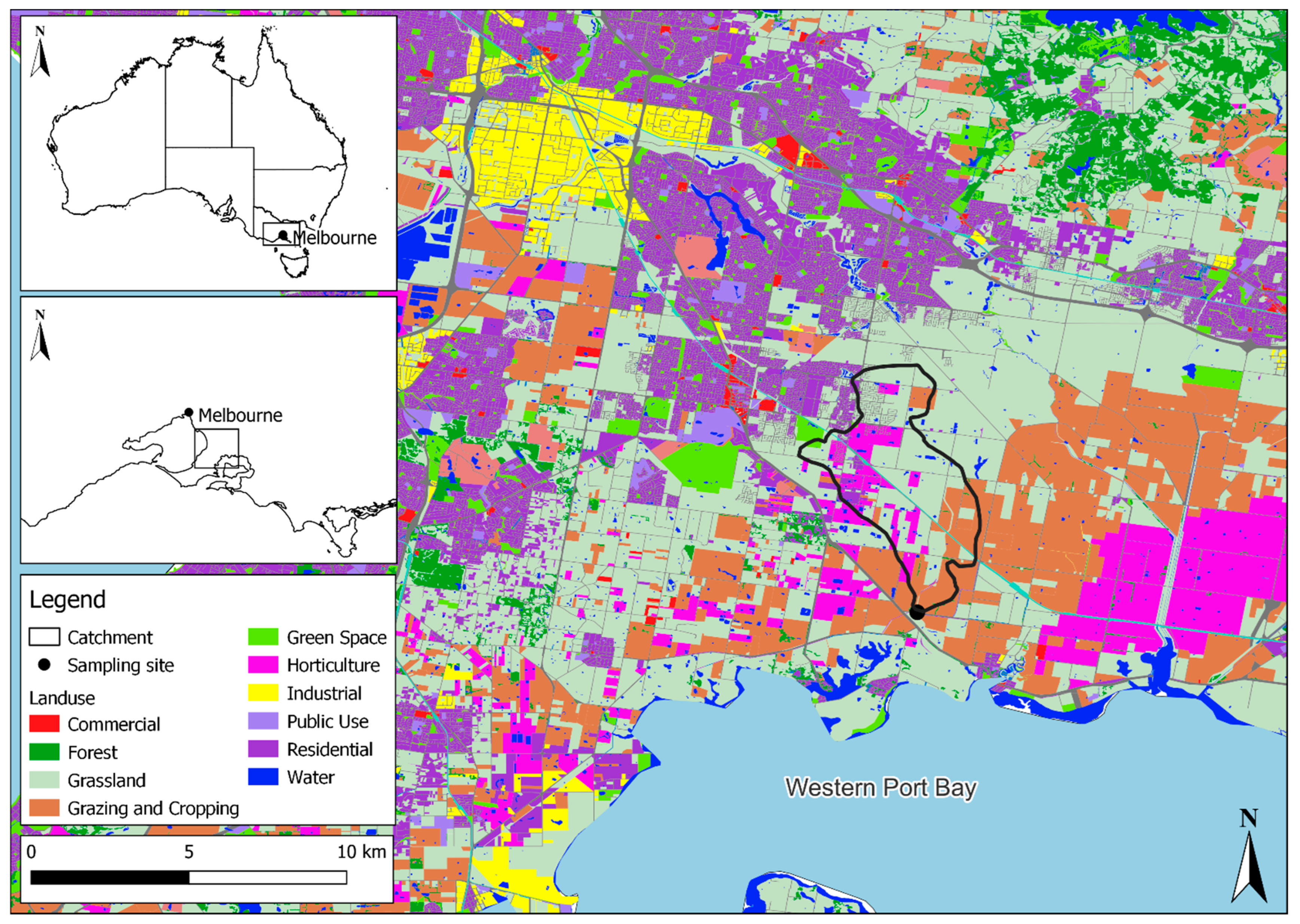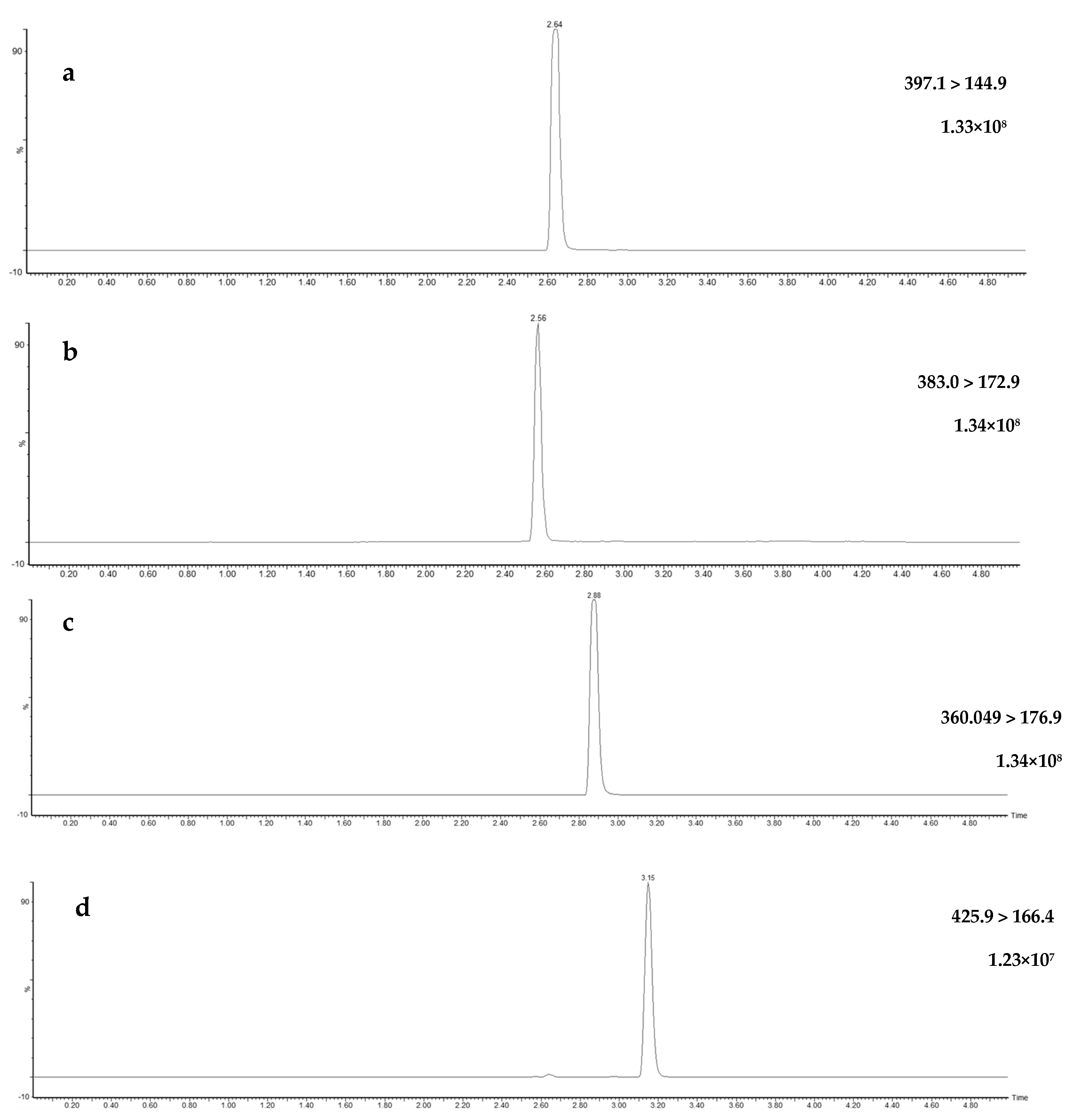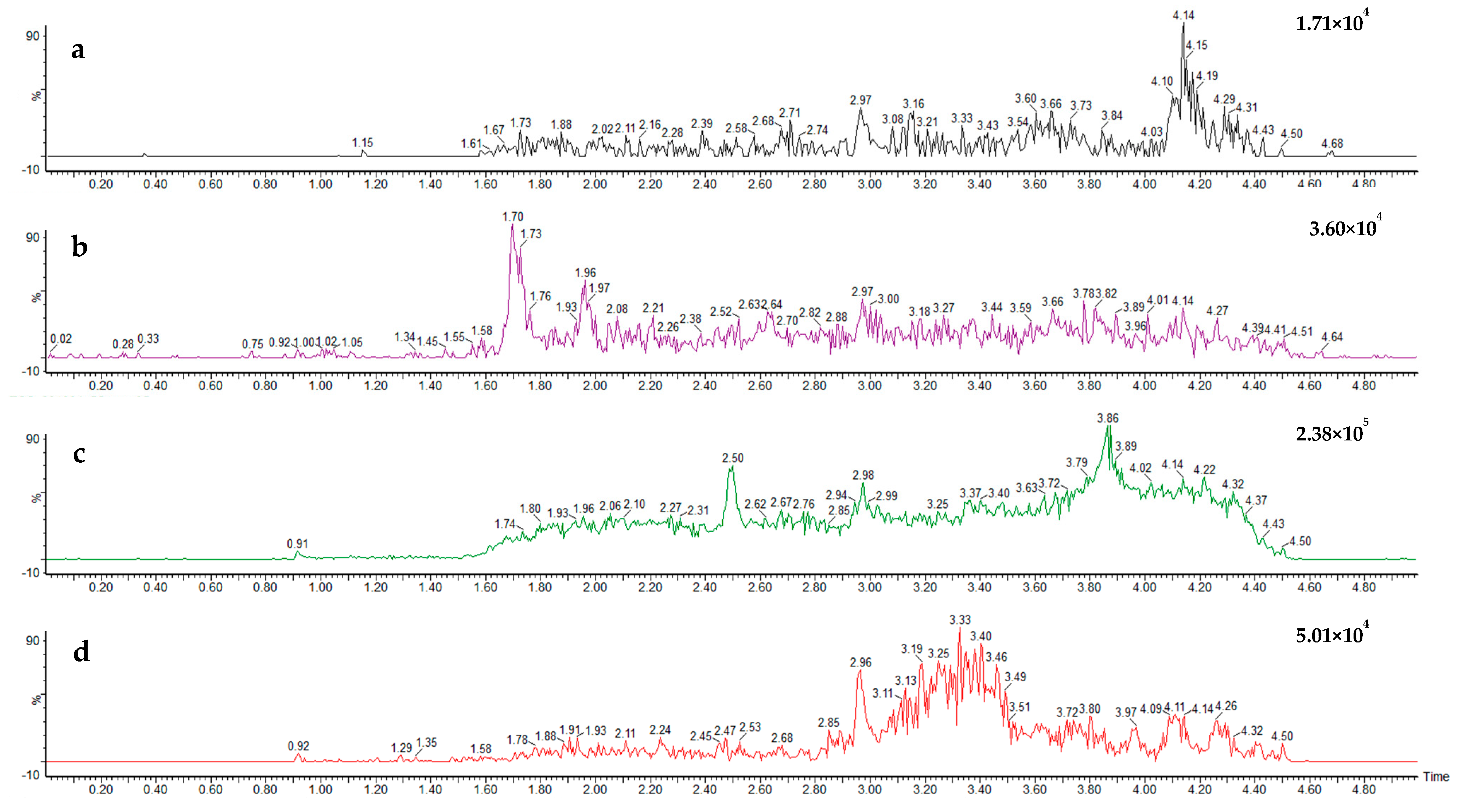Development and Validation of a Novel Method Using QuEChERS and UHPLC-MS-MS for the Determination of Multiple Emerging Fungicides in Surface Waters
Abstract
:1. Introduction
2. Materials and Methods
2.1. Reagents and Chemicals
2.2. Preparation of Standard Solution
2.3. Blank Matrices
2.4. Sample Preparation and Extraction
2.5. Quality Control
2.6. Instrumentation and Software
2.7. Method Validation and Matrix Effects
2.8. Applications to Surface Water Samples
3. Results and Discussion
3.1. Instrumental Method Optimization
3.2. Sample Preparation and Extraction
3.3. Method Validation
3.3.1. Linearity and Limit of Quantification
3.3.2. Precision and Accuracy
3.3.3. Estimation of Measurement Uncertainty
3.4. Method Application to Real-World Samples
4. Conclusions
Supplementary Materials
Author Contributions
Funding
Data Availability Statement
Acknowledgments
Conflicts of Interest
References
- Vryzas, Z.; Ramwell, C.; Sans, C. Pesticide prioritization approaches and limitations in environmental monitoring studies: From Europe to Latin America and the Caribbean. Environ. Int. 2020, 143, 105917. [Google Scholar] [CrossRef]
- Sharma, A.; Kumar, V.; Shahzad, B.; Tanveer, M.; Sidhu, G.P.S.; Handa, N.; Kohli, S.K.; Yadav, P.; Bali, A.S.; Parihar, R.D.; et al. Worldwide pesticide usage and its impacts on ecosystem. SN Appl. Sci. 2019, 1, 1446. [Google Scholar] [CrossRef]
- Kadiru, S.; Patil, S.; D’Souza, R. Effect of pesticide toxicity in aquatic environments: A recent review. Int. J. Fish Aquat. Stud 2022, 10, 113–118. [Google Scholar] [CrossRef]
- Cuevas, N.; Martins, M.; Costa, P.M. Risk assessment of pesticides in estuaries: A review addressing the persistence of an old problem in complex environments. Ecotoxicology 2018, 27, 1008–1018. [Google Scholar] [CrossRef] [PubMed]
- Mei, L.C.; Chen, H.M.; Dong, A.Y.; Huang, G.Y.; Liu, Y.W.; Zhang, X.; Wang, W.; Hao, G.F.; Yang, G.F. Pesticide Informatics Platform (PIP): An International Platform for Pesticide Discovery, Residue, and Risk Evaluation. J Agric Food Chem 2022, 70, 6617–6623. [Google Scholar] [CrossRef]
- Das, S.K. Mode of action of pesticides and the novel trends—A critical review. Int. Res. J. Agric. Sci. Soil Sci. 2013, 3, 393–401. [Google Scholar]
- Duarte Hospital, C.; Tête, A.; Debizet, K.; Imler, J.; Tomkiewicz-Raulet, C.; Blanc, E.B.; Barouki, R.; Coumoul, X.; Bortoli, S. SDHi fungicides: An example of mitotoxic pesticides targeting the succinate dehydrogenase complex. Environ. Int. 2023, 180, 108219. [Google Scholar] [CrossRef]
- Umetsu, N.; Shirai, Y. Development of novel pesticides in the 21st century. J. Pestic. Sci. 2020, 45, 54–74. [Google Scholar] [CrossRef]
- US EPA. US EPA—Pesticides—Fact Sheet for Fluopicolide; US EPA: Washington, DC, USA, 2007. [Google Scholar]
- Yanicostas, C.; Soussi-Yanicostas, N. SDHI Fungicide Toxicity and Associated Adverse Outcome Pathways: What Can Zebrafish Tell Us? Int. J. Mol. Sci. 2021, 22, 12362. [Google Scholar] [CrossRef]
- Marchand, P.A. EU Chemical Plant Protection Products in 2023: Current State and Perspectives. Agrochemicals 2023, 2, 106–117. [Google Scholar] [CrossRef]
- Gulkowska, A.; Buerge, I.; Poiger, T. Online solid phase extraction LC–MS/MS method for the analysis of succinate dehydrogenase inhibitor fungicides and its applicability to surface water samples. Anal. Bioanal. Chem. 2014, 406, 6419–6427. [Google Scholar] [CrossRef] [PubMed]
- Reilly, T.J.; Smalling, K.L.; Orlando, J.L.; Kuivila, K.M. Occurrence of boscalid and other selected fungicides in surface water and groundwater in three targeted use areas in the United States. Chemosphere 2012, 89, 228–234. [Google Scholar] [CrossRef] [PubMed]
- la Cecilia, D.; Dax, A.; Ehmann, H.; Koster, M.; Singer, H.; Stamm, C. Continuous high-frequency pesticide monitoring in a small tile-drained agricultural stream to reveal diel concentration fluctuations in dry periods. Front. Water 2023, 4, 1062198. [Google Scholar] [CrossRef]
- Nanusha, M.Y.; Frøkjær, E.E.; Liigand, J.; Christensen, M.R.; Hansen, H.R.; Hansen, M. Unravelling the occurrence of trace contaminants in surface waters using semi-quantitative suspected non-target screening analyses. Environ. Pollut. 2022, 315, 120346. [Google Scholar] [CrossRef]
- Lapworth, D.J.; Baran, N.; Stuart, M.E.; Manamsa, K.; Talbot, J. Persistent and emerging micro-organic contaminants in Chalk groundwater of England and France. Environ. Pollut. 2015, 203, 214–225. [Google Scholar] [CrossRef]
- Serasinghe, P.; Nguyen, H.T.K.; Hepburn, C.; Nugegoda, D.; Pettigrove, V. Use of passive sampling and high-resolution mass spectrometry for screening emerging pesticides of concern within surface waters. J. Hazard. Mater. Adv. 2024, 13, 100408. [Google Scholar] [CrossRef]
- Kim, S.; Chen, J.; Cheng, T.; Gindulyte, A.; He, J.; He, S.; Li, Q.; Shoemaker, B.A.; Thiessen, P.A.; Yu, B.; et al. PubChem 2019 update: Improved access to chemical data. Nucleic Acids Res. 2018, 47, D1102–D1109. [Google Scholar] [CrossRef]
- Xiao, P.; Liu, X.; Zhang, H.; Li, W. Chronic toxic effects of isoflucypram on reproduction and intestinal energy metabolism in zebrafish (Danio rerio). Environ. Pollut. 2022, 315, 120479. [Google Scholar] [CrossRef]
- Qian, L.; Qi, S.; Cao, F.; Zhang, J.; Li, C.; Song, M.; Wang, C. Effects of penthiopyrad on the development and behaviour of zebrafish in early-life stages. Chemosphere 2019, 214, 184–194. [Google Scholar] [CrossRef]
- Teng, M.; Zhu, W.; Wang, D.; Yan, J.; Qi, S.; Song, M.; Wang, C. Acute exposure of zebrafish embryo (Danio rerio) to flutolanil reveals its developmental mechanism of toxicity via disrupting the thyroid system and metabolism. Environ. Pollut. 2018, 242, 1157–1165. [Google Scholar] [CrossRef]
- Qian, L.; Qi, S.; Wang, Z.; Magnuson, J.T.; Volz, D.C.; Schlenk, D.; Jiang, J.; Wang, C. Environmentally relevant concentrations of boscalid exposure affects the neurobehavioral response of zebrafish by disrupting visual and nervous systems. J. Hazard. Mater. 2021, 404, 124083. [Google Scholar] [CrossRef] [PubMed]
- Yang, G.; Lv, L.; Di, S.; Li, X.; Weng, H.; Wang, X.; Wang, Y. Combined toxic impacts of thiamethoxam and four pesticides on the rare minnow (Gobiocypris rarus). Environ. Sci. Pollut. Res. 2021, 28, 5407–5416. [Google Scholar] [CrossRef] [PubMed]
- APVMA. Public Chemical Registration Information System—PUBCRIS. Available online: https://portal.apvma.gov.au/pubcris (accessed on 18 June 2020).
- Beretov, J.; Wasinger, V.C.; Graham, P.H.; Millar, E.K.; Kearsley, J.H.; Li, Y. Proteomics for breast cancer urine biomarkers. Adv. Clin. Chem. 2014, 63, 123–167. [Google Scholar] [CrossRef]
- Hajeb, P.; Zhu, L.; Bossi, R.; Vorkamp, K. Sample preparation techniques for suspect and non-target screening of emerging contaminants. Chemosphere 2022, 287, 132306. [Google Scholar] [CrossRef] [PubMed]
- Suseela, M.N.L.; Viswanadh, M.K.; Mehata, A.K.; Priya, V.; Vikas; Setia, A.; Malik, A.K.; Gokul, P.; Selvin, J.; Muthu, M.S. Advances in solid-phase extraction techniques: Role of nanosorbents for the enrichment of antibiotics for analytical quantification. J. Chromatogr. A 2023, 1695, 463937. [Google Scholar] [CrossRef]
- Samsidar, A.; Siddiquee, S.; Shaarani, S.M. A review of extraction, analytical and advanced methods for determination of pesticides in environment and foodstuffs. Trends Food Sci. Technol. 2018, 71, 188–201. [Google Scholar] [CrossRef]
- Lee, Y.J.; Choi, J.H.; Abd El-Aty, A.; Chung, H.S.; Lee, H.S.; Kim, S.W.; Rahman, M.M.; Park, B.J.; Kim, J.E.; Shin, H.C. Development of a single-run analytical method for the detection of ten multiclass emerging contaminants in agricultural soil using an acetate-buffered QuEChERS method coupled with LC–MS/MS. J. Sep. Sci. 2017, 40, 415–423. [Google Scholar] [CrossRef]
- Li, L.; Yin, Y.; Zheng, G.; Liu, S.; Zhao, C.; Xie, W.; Ma, L.; Shan, Q.; Dai, X.; Wei, L. Determination of multiclass herbicides in sediments and aquatic products using QuECHERS combined with ultra-high performance liquid chromatography-tandem mass spectrometry (UHPLC-MS/MS) and its application to risk assessment of rice-fish co-culture system in China. Microchem. J. 2021, 170, 106628. [Google Scholar] [CrossRef]
- Song, N.-E.; Jung, Y.S.; Choi, J.Y.; Koo, M.; Choi, H.-K.; Seo, D.-H.; Lim, T.-G.; Nam, T.G. Development and application of a multi-residue method to determine pesticides in agricultural water using QuEChERS extraction and LC-MS/MS analysis. Separations 2020, 7, 52. [Google Scholar] [CrossRef]
- Bian, C.; Gao, M.; Liu, L.; Zhou, W.; Li, Y.; Wan, C.; Li, B. Determination of Pydiflumetofen Residues in Rice and its Environment by an Optimized QuEChERS Method Coupled with HPLC-MS. Bull. Environ. Contam. Toxicol. 2021, 107, 239–247. [Google Scholar] [CrossRef]
- Englert, B. Method 1699: Pesticides in Water, Soil, Sediment, Biosolids, and Tissue by HRGC/HRMS; US Environmental Protection Agency (EPA): Washington, DC, USA, 2007; pp. 1–96. [Google Scholar]
- ISO/IEC 17025; General Requirements for the Competence of Testing and Calibration Laboratories. International Organisation for Standardisation, Croatian Standard Institute: Zagreb, Croatia, 2007.
- Koçyiğit, H.; Sinanoğlu, F. Method validation for the analysis of pesticide residue in aqueous environment. Environ. Monit. Assess 2020, 192, 567. [Google Scholar] [CrossRef] [PubMed]
- Zaidon, S.Z.; Ho, Y.B.; Hamsan, H.; Hashim, Z.; Saari, N.; Praveena, S.M. Improved QuEChERS and solid phase extraction for multi-residue analysis of pesticides in paddy soil and water using ultra-high performance liquid chromatography tandem mass spectrometry. Microchem. J. 2019, 145, 614–621. [Google Scholar] [CrossRef]
- Magnusson, B. The Fitness for Purpose of Analytical Methods: A Laboratory Guide to Method Validation and Related Topics (2014); Euracheml: Lisboa, Portugal, 2014; p. 2. [Google Scholar]
- European Commission. Guidance Document on Analytical Quality Control and Method Validation Procedures for Pesticide Residues and Analysis in Food and Feed; SANTE/12682/2019; European Commission: Brussels, Belgium, 2020. [Google Scholar]
- Spatial Economics. Land Use Projections Greater Metropolitan Melbourne 2016 to 2051. 2016. Available online: https://www.portphillip.vic.gov.au/media/iu5h5tdo/11-2-att-1-draft-yarra-catchment-integrated-water-management-plan.pdf (accessed on 20 September 2024).
- Wang, S.; Wang, X.; He, Q.; Lin, H.; Chang, H.; Sun, H.; Liu, Y. Simultaneous Determination of Seven Pesticides and Metabolite Residues in Litchi and Longan through High-Performance Liquid Chromatography-Tandem Mass Spectrometry with Modified QuEChERS. Molecules 2022, 27, 5737. [Google Scholar] [CrossRef] [PubMed]
- Rizzetti, T.M.; Kemmerich, M.; Martins, M.L.; Prestes, O.D.; Adaime, M.B.; Zanella, R. Optimization of a QuEChERS based method by means of central composite design for pesticide multiresidue determination in orange juice by UHPLC–MS/MS. Food Chem. 2016, 196, 25–33. [Google Scholar] [CrossRef]
- Su, Y.; Lu, J.; Liu, J.; Li, F.; Wang, N.; Lei, H.; Shen, X. Optimization of a QuEChERS-LC-MS/MS method for 51 pesticide residues followed by determination of the residue levels and dietary intake risk assessment in foodstuffs. Food Chem 2024, 434, 137467. [Google Scholar] [CrossRef]
- Guillarme, D.; Dong, M. UHPLC, Part II: Benefits. LCGC N. Am. 2017, 35, 486–495. [Google Scholar]
- Behnoush, B.; Sheikhazadi, A.; Bazmi, E.; Fattahi, A.; Sheikhazadi, E.; Saberi Anary, S.H. Comparison of UHPLC and HPLC in benzodiazepines analysis of postmortem samples: A case-control study. Medicine 2015, 94, e640. [Google Scholar] [CrossRef]
- Frenich, A.G.; Romero-González, R.; del Mar Aguilera-Luiz, M. Comprehensive analysis of toxics (pesticides, veterinary drugs and mycotoxins) in food by UHPLC-MS. TrAC Trends Anal. Chem. 2014, 63, 158–169. [Google Scholar] [CrossRef]
- Swetha, S.R.; Bhavya, S.K.; Mounika, C. A Review on Comparative study of HPLC and UPLC. Res. J. Pharm. Technol. 2020, 13, 1570–1574. [Google Scholar] [CrossRef]
- Chawla, G.; Ranjan, C. Principle, instrumentation, and applications of UPLC: A novel technique of liquid chromatography. Open Chem. J. 2016, 3. [Google Scholar] [CrossRef]
- Ren, D.-B.; Yang, Z.-H.; Liang, Y.-Z.; Fan, W.; Ding, Q. Effects of injection volume on chromatographic features and resolution in the process of counter-current chromatography. J. Chromatogr. A 2013, 1277, 7–14. [Google Scholar] [CrossRef] [PubMed]
- Hogenboom, A.C.; Hofman, M.P.; Kok, S.J.; Niessen, W.M.; Brinkman, U.A. Determination of pesticides in vegetables using large-volume injection column liquid chromatography-electrospray tandem mass spectrometry. J. Chromatogr. A 2000, 892, 379–390. [Google Scholar] [CrossRef] [PubMed]
- Acosta-Dacal, A.; Rial-Berriel, C.; Díaz-Díaz, R.; Bernal-Suárez, M.d.M.; Luzardo, O.P. Optimization and validation of a QuEChERS-based method for the simultaneous environmental monitoring of 218 pesticide residues in clay loam soil. Sci. Total Environ. 2021, 753, 142015. [Google Scholar] [CrossRef] [PubMed]
- Golge, O.; Koluman, A.; Kabak, B. Validation of a Modified QuEChERS Method for the Determination of 167 Pesticides in Milk and Milk Products by LC-MS/MS. Food Anal. Methods 2018, 11, 1122–1148. [Google Scholar] [CrossRef]
- Berlioz-Barbier, A.; Vauchez, A.; Wiest, L.; Baudot, R.; Vulliet, E.; Cren-Olivé, C. Multi-residue analysis of emerging pollutants in sediment using QuEChERS-based extraction followed by LC-MS/MS analysis. Anal. Bioanal. Chem. 2014, 406, 1259–1266. [Google Scholar] [CrossRef]
- Jing, W.; Nakano, K.; Shen, Z.; Okuda, T. Optimization of the QuEChERS extraction method to determine Polycyclic Aromatic Hydrocarbons (PAHs) in powder aerosol particles collected by cyclone. Environ. Technol. Innov. 2023, 31, 103141. [Google Scholar] [CrossRef]
- Perestrelo, R.; Silva, P.; Porto-Figueira, P.; Pereira, J.A.M.; Silva, C.; Medina, S.; Câmara, J.S. QuEChERS - Fundamentals, relevant improvements, applications and future trends. Anal. Chim. Acta 2019, 1070, 1–28. [Google Scholar] [CrossRef]
- Ho, Y.B.; Zakaria, M.P.; Latif, P.A.; Saari, N. Simultaneous determination of veterinary antibiotics and hormone in broiler manure, soil and manure compost by liquid chromatography–tandem mass spectrometry. J. Chromatogr. A 2012, 1262, 160–168. [Google Scholar] [CrossRef]
- Wightwick, A.M.; Bui, A.D.; Zhang, P.; Rose, G.; Allinson, M.; Myers, J.H.; Reichman, S.M.; Menzies, N.W.; Pettigrove, V.; Allinson, G. Environmental fate of fungicides in surface waters of a horticultural-production catchment in southeastern Australia. Arch. Environ. Contam. Toxicol. 2012, 62, 380–390. [Google Scholar] [CrossRef]
- Spycher, S.; Mangold, S.; Doppler, T.; Junghans, M.; Wittmer, I.; Stamm, C.; Singer, H. Pesticide Risks in Small Streams—How to Get as Close as Possible to the Stress Imposed on Aquatic Organisms. Environ. Sci. Technol. 2018, 52, 4526–4535. [Google Scholar] [CrossRef]
- Sjerps, R.M.A.; Kooij, P.J.F.; van Loon, A.; Van Wezel, A.P. Occurrence of pesticides in Dutch drinking water sources. Chemosphere 2019, 235, 510–518. [Google Scholar] [CrossRef] [PubMed]
- Rathod, P.; Shah, P.; Parmar, K.; Kalasariya, R. The Fate of Fluopyram in the Soil–Water–Plant Ecosystem: A Review. Rev. Environ. Contam. Toxicol. 2022, 260, 1. [Google Scholar] [CrossRef]
- APVMA. Submission to the Productivity Commission inquiry into Regulation of Australian Agriculture; APVMA: Armidale, Australia, 2016. [Google Scholar]
- Dong, B.; Hu, J. Photodegradation of the novel fungicide fluopyram in aqueous solution: Kinetics, transformation products, and toxicity evolvement. Environ. Sci. Pollut. Res. 2016, 23, 19096–19106. [Google Scholar] [CrossRef] [PubMed]
- Hu, J.; Pang, K.; Dong, B.Z. Mechanism and identify photolysis products of fluopyram under TiO2: Experiments, DFT and ab initio Molecular dynamics study. SDRP J. Earth Sci. Environ. Stud. 2019, 4, 681–690. [Google Scholar] [CrossRef]
- Zhan, J.; Liang, Y.; Liu, D.; Liu, C.; Liu, H.; Wang, P.; Zhou, Z. Organochlorine pesticide acetofenate and its hydrolytic metabolite in rabbits: Enantioselective metabolism and cytotoxicity. Pestic. Biochem. Physiol. 2018, 145, 76–83. [Google Scholar] [CrossRef]
- Li, C.; Yuan, S.; Jiang, F.; Xie, Y.; Guo, Y.; Yu, H.; Cheng, Y.; Qian, H.; Yao, W. Degradation of fluopyram in water under ozone enhanced microbubbles: Kinetics, degradation products, reaction mechanism, and toxicity evaluation. Chemosphere 2020, 258, 127216. [Google Scholar] [CrossRef]
- Pazikowska-Sapota, G.; Galer-Tatarowicz, K.; Dembska, G.; Wojtkiewicz, M.; Duljas, E.; Pietrzak, S.; Dzierzbicka-Glowacka, L.A. The impact of pesticides used at the agricultural land of the Puck commune on the environment of the Puck Bay. PeerJ 2020, 8, e8789. [Google Scholar] [CrossRef]
- Wen, S.; Wang, Y.; Wang, X.; Liu, C.; Xue, Y.; Liu, C.; Wang, J.; Xia, X. Fluopicolide-Induced Oxidative Stress and DNA Damage in the Earthworm Eisenia foetida. Toxics 2023, 11, 808. [Google Scholar] [CrossRef]
- Jin, L.; Yun, G.; Wei, M.; Kaiyun, W.; Hui, X.; Jie, L. Acute toxicity of fluopicolide to 9 kinds of environmental organisms and its bioaccumulation in zebrafish. Asian J. Ecotoxicol. 2016, 6, 296–305. [Google Scholar]
- Lin, J.; Wang, H.; Wang, K.; Fan, W.; Xu, H.; Liu, J. Toxic effects of fluopicolide on zebrafish. China Environ. Sci. 2014, 34, 3230–3236. [Google Scholar]
- Lopez, B.; Ollivier, P.; Togola, A.; Baran, N.; Ghestem, J.-P. Screening of French groundwater for regulated and emerging contaminants. Sci. Total Environ. 2015, 518–519, 562–573. [Google Scholar] [CrossRef] [PubMed]
- Postigo, C.; Barceló, D. Synthetic organic compounds and their transformation products in groundwater: Occurrence, fate and mitigation. Sci. Total Environ. 2015, 503–504, 32–47. [Google Scholar] [CrossRef] [PubMed]
- Adasakaveg, E.J.; Michailides, T.; Eskalen, A. Fungicides, Bactericides, Biocontrols, and Natural Products for Deciduous Tree Fruit and Nut, Citrus, Strawberry, and Vine Crops in California; University of California Agriculture and Natural Resources: Davis, CA, USA, 2022. [Google Scholar]
- Wang, Z.; Liu, S.; Zhao, X.; Tian, B.; Sun, X.; Zhang, J.; Gao, Y.; Shi, H.; Wang, M. Enantioseparation and stereoselective dissipation of the novel chiral fungicide pydiflumetofen by ultra-high-performance liquid chromatography tandem mass spectrometry. Ecotoxicol. Envioron. Saf. 2021, 207, 111221. [Google Scholar] [CrossRef] [PubMed]
- Ren, B.; Liang, H.; Li, L.; Li, Y.; Liang, H.; Zhao, T.; Chen, H.; Zhao, Y. Enantioselective toxic effects of the novel chiral antifungal agrochemical penthiopyrad in the early life stage of zebrafish (Danio rerio). Chem.-Biol. Interact. 2023, 369, 110252. [Google Scholar] [CrossRef]
- Yang, G.; Liu, Z.; Lan, T.; Dou, L.; Zhang, K. Potential enantioselectivity of the hydrolysation and photolysation of the chiral agrochemical penthiopyrad in aquatic environments. Environ. Sci. Water Res. Technol. 2021, 7, 1220–1229. [Google Scholar] [CrossRef]
- Wang, Z.; Tan, Y.; Li, Y.; Duan, J.; Wu, Q.; Li, R.; Shi, H.; Wang, M. Comprehensive study of pydiflumetofen in Danio rerio: Enantioselective insight into the toxic mechanism and fate. Environ. Int. 2022, 167, 107406. [Google Scholar] [CrossRef]
- Di, S.; Cang, T.; Liu, Z.; Xie, Y.; Zhao, H.; Qi, P.; Wang, Z.; Xu, H.; Wang, X. Comprehensive evaluation of chiral pydiflumetofen from the perspective of reducing environmental risks. Sci. Total Environ. 2022, 826, 154033. [Google Scholar] [CrossRef]
- Ren, B.; Zhao, T.; Li, Y.; Liang, H.; Zhao, Y.; Chen, H.; Li, L.; Liang, H. Enantioselective bioaccumulation and toxicity of the novel chiral antifungal agrochemical penthiopyrad in zebrafish (Danio rerio). Ecotoxicol. Environ. Saf. 2021, 228, 113010. [Google Scholar] [CrossRef]




| Pesticides | R.T (min) | Precursor Ion (m/z) | Quantification Transition (m/z) | D.P (V) | C.E (V) | Qualifier Transition (m/z) | D.P (V) | C.E (V) |
|---|---|---|---|---|---|---|---|---|
| Fluopicolide | 2.62 | 383.0 | 172.9 | 40 | 20 | 365 | 40 | 15 |
| Fluopyram | 2.67 | 397.1 | 144.9 | 25 | 60 | 207.9 | 25 | 24 |
| Penthiopyrad | 2.91 | 360.0 | 176.9 | 10 | 43 | 256 | 14 | 29 |
| Pydiflumetofen | 3.19 | 425.9 | 166.4 | 110 | 30 | 192.9 | 110 | 40 |
| Triphenylphosphate | 2.99 | 326.7 | 76.9 | 2 | 36 | 151.9 | 2 | 22 |
| Pesticides | LOD (µg/L) | LOQ (µg/L) | Mean Bias (%) | SD. P Bias (%) | RMS Bias (%) | (%) | (%) |
|---|---|---|---|---|---|---|---|
| Fluopicolide | 0.1 | 0.3 | 4 | 8 | 9 | 11 | 22 |
| Fluopyram | 0.1 | 0.3 | 4 | 7 | 8 | 10 | 20 |
| Penthiopyrad | 0.1 | 0.4 | −4 | 7 | 8 | 11 | 21 |
| Pydiflumetofen | 0.2 | 0.6 | −2 | 12 | 12 | 18 | 35 |
| Spiked Level (µg/L) | |||||||||||||||
|---|---|---|---|---|---|---|---|---|---|---|---|---|---|---|---|
| Mean Recovery (%) | Intra-Day RSD (%) | ||||||||||||||
| Pesticide | Linearity (R2) | 0.5 | 1 | 2 | 5 | 25 | 50 | 100 | 0.5 | 1 | 2 | 5 | 25 | 50 | 100 |
| Fluopicolide | 0.999 | 95.3 | 106.7 | 108.8 | 106.3 | 105.8 | 103.2 | - | 6.1 | 5 | 7.4 | 6.3 | 9.2 | 7.2 | - |
| Fluopyram | 0.999 | 96.6 | 105.9 | 107.8 | 105.4 | 104.9 | 102.8 | - | 4.5 | 6.3 | 6.5 | 5.7 | 8.1 | 5.1 | - |
| 0.5 | 1 | 2 | 5 | 25 | 50 | 100 | 0.5 | 1 | 2 | 5 | 25 | 50 | 100 | ||
| Penthiopyrad | 0.999 | 90.4 | 95.6 | 100 | 98.1 | 96.1 | 96.4 | 101.2 | 7.9 | 6.3 | 2.8 | 8.5 | 9.2 | 6.9 | 6.5 |
| Pydiflumetofen | 0.998 | 94.3 | 90 | 100.3 | 105.5 | 100.2 | 100.2 | 98.3 | 12.3 | 6.8 | 7.4 | 13.1 | 18.7 | 12.2 | 12.9 |
| Mean Pesticide Concentration (µg/L) | ||||
|---|---|---|---|---|
| Month | Fluopyram | Fluopicolide | Penthiopyrad | Pydiflumetofen |
| May | 7.3 | ND | 0.11 * | ND |
| June | ND | ND | 0.14 * | 0.19 * |
| Sept | ND | 0.15 * | 0.16 * | ND |
Disclaimer/Publisher’s Note: The statements, opinions and data contained in all publications are solely those of the individual author(s) and contributor(s) and not of MDPI and/or the editor(s). MDPI and/or the editor(s) disclaim responsibility for any injury to people or property resulting from any ideas, methods, instructions or products referred to in the content. |
© 2024 by the authors. Licensee MDPI, Basel, Switzerland. This article is an open access article distributed under the terms and conditions of the Creative Commons Attribution (CC BY) license (https://creativecommons.org/licenses/by/4.0/).
Share and Cite
Serasinghe, P.; Taleski, D.; Nguyen, H.T.K.; Nugegoda, D.; Pettigrove, V. Development and Validation of a Novel Method Using QuEChERS and UHPLC-MS-MS for the Determination of Multiple Emerging Fungicides in Surface Waters. Separations 2024, 11, 279. https://doi.org/10.3390/separations11100279
Serasinghe P, Taleski D, Nguyen HTK, Nugegoda D, Pettigrove V. Development and Validation of a Novel Method Using QuEChERS and UHPLC-MS-MS for the Determination of Multiple Emerging Fungicides in Surface Waters. Separations. 2024; 11(10):279. https://doi.org/10.3390/separations11100279
Chicago/Turabian StyleSerasinghe, Pulasthi, Deni Taleski, Hao T. K. Nguyen, Dayanthi Nugegoda, and Vincent Pettigrove. 2024. "Development and Validation of a Novel Method Using QuEChERS and UHPLC-MS-MS for the Determination of Multiple Emerging Fungicides in Surface Waters" Separations 11, no. 10: 279. https://doi.org/10.3390/separations11100279







